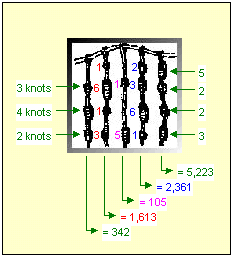The Quipu
The Quipu was a system of knotted cords used by the Incas and its predecessor societies in the Andean region to store massive amounts of information important to their culture and civilization.
Quipu is the Spanish spelling and the most common spelling in English. Khipu is the word for "knot" in Cusco Quechua (the native Inca language).
The colors of the cords, the way the cords are connected together, the spaces between the cords, the types of knots on the individual cords, and the relative placement of the knots are all part of the logical-numerical recording. For example, a yellow strand might represent gold or maize; or on a population quipu
the first set of strands represented men, the second set women, and the third
set children. Weapons such as spears, arrows, or bows were similarly designated.
The combination of fiber types, dye colors, and intricate knotting could be a novel form of written language, according to Harvard anthropologist Gary Urton. He claims that the quipus contain a seven-bit binary code capable of conveying more than 1,500 separate units of information.
Quipus were knotted ropes using a positional decimal system. A knot in a row farthest from the main strand represented one, next farthest ten, etc. The absence of knots on a cord implied zero

|